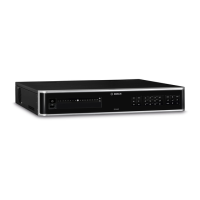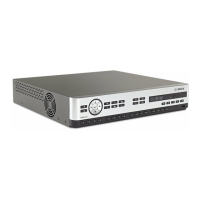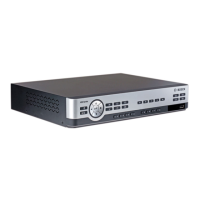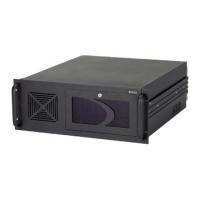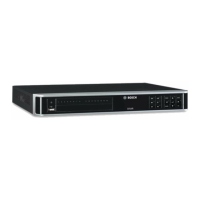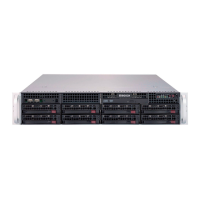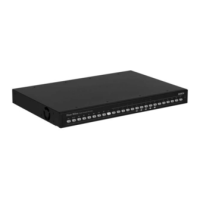Do you have a question about the Bosch DVR 440 and is the answer not in the manual?
Explains risk levels associated with safety symbols and potential consequences of not avoiding hazards.
Provides essential safety guidelines for operating the unit, covering cleaning, heat sources, ventilation, water, etc.
Details crucial notices regarding unit installation, maintenance, disposal, and environmental considerations.
Outlines FCC compliance information for digital devices, including interference guidelines and corrective measures.
Provides information on copyright, trademarks, and general notes regarding the manual and product.
Explains the DVR's function as a video and audio recording system with live viewing and playback features.
Differentiates between DVR 440 (4-channel) and DVR 480 (8-channel) models.
Lists the manuals and documentation available for the product, covering installation, operation, and software.
Details the key features of the DVR 440/480 Series, including inputs, outputs, compression, and connectivity.
Guides the user on inspecting the package for damage and carefully unpacking the electronic equipment.
Lists the items included in the package, such as the DVR unit, manuals, power supply, and CD-ROM.
Details the recommended environment for installation, including mounting, ventilation, temperature, and power supply.
Lists typical components that are part of a system but not included with the unit.
Warns that failure to follow instructions may damage the unit and void the warranty.
Guides the user through making the necessary connections for the unit's operation.
Details the essential connections required for the unit to function, such as cameras, monitor A, and mouse.
Outlines optional connections like monitor B, audio, alarms, network, and PTZ control.
Provides instructions on powering up the unit and connected equipment.
Guides the user through the initial setup process using the Quick install menu.
Explains the three tabs of the Quick install menu: International, Continuous Recording, and Network.
Covers language, time zone, and date/time formatting settings within the Quick Install menu.
Allows setting resolution, quality, frame rate, covert, and audio for continuous recording.
Guides network configuration, including DVR ID, DHCP, and IP address settings.
Details how to connect cameras using VIDEO IN BNC connectors and explains automatic PAL/NTSC detection.
Explains how to connect audio input and output using RCA connectors.
Describes how to connect up to two monitors via VGA and CVBS connections.
Details connecting Monitor A using a VGA cable and its specifications.
Explains connecting a CCTV monitor using CVBS video output and its specifications.
Describes connecting to a PC or converter via the RS-232 COM port and lists pin details.
Details connecting to a PC or network via the RJ-45 Ethernet port, including specifications and pinouts.
Explains the location and use of USB 2.0 ports for mouse or memory devices.
Describes the RS485 port for controlling PTZ cameras and its supported baud settings.
Details connecting alarm inputs and outputs using terminal blocks, including specifications and warnings.
Explains the DC power supply unit, its specifications, and the unit's lack of an on/off switch.
Provides guidance on unit maintenance, emphasizing external cleaning and referring servicing to qualified personnel. Includes a DANGER warning.
Details user levels (Administrator, Advanced, Normal) and their permissions for accessing unit functions.
Identifies and describes the front panel controls and keys of the 4-channel and 8-channel models.
Explains the functions of various keys on the front panel, including arrow keys, Enter, Menu, Search, Export, PTZ, Zoom.
Continues explaining key functions like Exit, Alarm, Camera, Quad, Sequence, OSD, Digital Zoom, Multi-screen, Pause, Reverse, Play, Fast forward, Stop.
Describes the meaning of the front panel indicators for Power, Network, and Record status.
Explains how to control the DVR functions using a USB mouse via the System Control Bar.
Details how to use the supplied IR remote control for unit operation and setting IDs.
Explains how the two monitor outputs (A and B) display pictures based on system configuration.
Details how to control the display (full-screen, quad) on Monitor A using mouse controls.
Explains how to control the display on Monitor B using mouse controls.
Lists available multi-screen views for Monitor A based on resolution and model type, and how to activate quad, full-screen, multi-screen, and sequence views.
Describes how to assign cameras to cameos in quad or multi-screen views.
Explains how to freeze an image on Monitor A using front panel keys or mouse.
Details how to zoom in on a video image using front panel keys or mouse.
Differentiates between Live mode and Playback mode and how to switch between them.
Describes the normal operating mode where live pictures are viewed from cameras.
Explains how to enter and use playback mode, including video control keys.
Provides an overview of the menu system, accessible via front panel keys or USB mouse.
Details how to open the main menu using the front panel keys and navigate through it.
Explains how to open and navigate the menu system using a USB mouse.
Lists the submenus within the main menu categories: Camera, Schedule, Display, Event, Network, System.
Explains how to access the search function using the front panel key or mouse.
Guides on how to perform a search by specifying a date and time, and using zoom to magnify the timeline.
Details how to search for specific events like alarms or motion detection by setting criteria.
Explains how to use smart search by defining channel, time, sensitivity, and area for detection.
Describes how to export recorded video and audio segments to a USB storage device.
Explains how to access system information like model name, serial number, IP address, and software version.
Shows the system video mode and the status of detected video signals for each input.
Provides information on hard disk size, usage, and certification status.
Explains how to access and filter the system log to view historic events.
Explains how events like alarm inputs, motion, or video loss trigger responses from the unit.
Details how alarm inputs can cause events and how the unit displays these alarms on monitors.
Describes the process of acknowledging an input alarm to silence beepers and clear indicators.
Explains how motion detection events are displayed and indicated.
Describes how video loss is indicated and acknowledged.
Explains how the unit displays multiple alarms and how to acknowledge them.
Accesses camera-specific settings like video adjustment, PTZ, and recording modes.
Allows setting recording schedules based on day, time, and exception days.
Configures display settings for Monitor A and Monitor B, including language and OSD items.
Configures behavior for inputs, motion detection, system failures, and alarm acknowledgments.
Configures network settings like TCP/IP, DDNS, notifications, and mail.
Configures system-wide settings such as Date/Time, NTP, Beeper, Users, Hard Disk, and general System settings.
Allows configuring recording settings for Continuous, Input, and Motion recording profiles.
Enables video and audio inputs, sets camera names, and configures covert settings.
Lists maximum frame rates for the DVR 440 model based on resolution and channels enabled.
Lists maximum frame rates for the DVR 480 model based on resolution and channels enabled.
Allows adjustment of camera video settings like brightness, contrast, and color.
Configures PTZ settings for controllable cameras, including COM port, control ID, and protocol.
Sets resolution, quality, and frame rate for continuous recording mode.
Configures pre-event and post-event recording settings for input-triggered recording.
Configures resolution, quality, frame rate, and pre/post-event settings for motion-activated recording.
Configures settings for streaming video over the network, including resolution and frame rate.
Selects the video format (NTSC, PAL, Auto detect) and VGA output resolution.
Allows setting dynamic recording schedules using different record modes for various times and days.
Details the configuration of the weekly schedule, including setting modes at 1-hour intervals and exception days.
Configures display settings for Monitor A and Monitor B, such as language and OSD items.
Allows selecting the display language for the unit.
Selects items displayed on Monitor A and sets sequence dwell times.
Specifies that the procedure is the same as for Monitor A.
Configures desired behavior for inputs, motion detection, system failures, and alarm acknowledgment.
Configures behavior for input events, including input type, associated camera, relay output, and PTZ preset.
Configures motion detection sensitivity, relay output, and the motion-sensitive area.
Configures automatic or manual operation for alarm acknowledgment.
Configures relay outputs to react to specific system events like disk fail or video loss.
Provides access to network configuration options.
Configures TCP/IP settings, including DHCP, IP address, subnet mask, gateway, bandwidth, RTSP, and ICMP.
Explains the RTSP feature for live video streaming to mobile devices, with attention to firewall settings.
Guides on connecting a smart phone to view live-view channels using RTSP.
Allows selection of a DDNS provider and input of configuration details.
Configures events that will trigger the unit to send an email notification.
Configures email settings, including SMTP server, port, SSL, user credentials, and recipient details.
Provides access to system-wide configurations.
Sets the unit's date, time, time zone, and daylight saving options.
Configures the unit to synchronize time with a network time server or NTP-capable device.
Configures when the unit will produce beep sounds for button presses or triggered events.
Manages user accounts, including Administrator and user-defined accounts with permission levels.
Manages configuration files, including importing, exporting, resetting defaults, and updating firmware.
Configures hard disk settings like overwrite, disk full warning, event partition, auto delete, and formatting.
Configures IR remote control settings, DVR ID, and auto user logout period.
Guides on how to get started with the Web Client software for remote control.
Lists the PC system requirements for using the Web Client software.
Details the process of connecting to the DVR for the first time via Internet Explorer.
Explains how to log on to the DVR using the Web Client software with user ID and password.
Describes the main areas of the Web Client browser window.
Explains how to view live video through the Web Client interface.
Details how to control PTZ cameras (pan, tilt) using the Web Client interface.
Explains how to control zoom, focus, and iris for PTZ cameras via the Web Client.
Describes how to move PTZ cameras to pre-defined positions and store new ones.
Explains how to switch between single, quad, sequence, and full-screen camera views in the Web Client.
Explains how to use the playback mode in the Web Client to view recorded video.
Details how to export files remotely to a PC using the Web Client.
Allows setup of all configuration settings for the unit via the Web Client.
Introduces the Archive Player for viewing archived video and checking authenticity.
Lists the PC system requirements for the Archive Player.
States that the Archive Player does not require installation and is copied with archive files.
Explains how to start the Archive Player program.
Describes the main window components of the Archive Player.
Explains how to open an archive file to view it.
Describes how to switch display modes (single, quad) and zoom within the Archive Player.
Explains how to assign cameras to cameos for multiscreen displays.
Details the process of assigning a camera to a cameo.
Explains how to use playback controls like Play, Play Reverse, Still, Step Forward/Backward.
Describes how to capture and save still images from the Archive Player.
Explains how to find an image by entering a date and time.
Mentions the video slider bar for playback time adjustment.
Explains how to check the authenticity of archived video.
Describes how to exit the Archive Player application.
Lists default values for settings in the Quick Install menu.
Lists default values for various configuration menu settings.
Lists default values for search settings.
Lists default values for archive settings.
Details electrical specifications including voltage, power input/output, and internal battery.
Lists video input/output standards, resolution, AGC, digital zoom, and compression.
Specifies audio input/output formats, sample rate, and compression.
Details alarm input and output specifications.
Lists specifications for RS232 and RS485 control interfaces.
Lists all connectors used by the unit, including video, audio, Ethernet, monitors, and alarm.
Lists RS485 terminal output specifications and cable cross section.
Details USB connector type and usage for mouse and memory devices.
Lists specifications for hard disks, record rate, resolution, and quality.
Lists display modes for Monitor A and Monitor B.
Specifies the available recording modes.
Provides dimensions and weight specifications for the DVR units.
Lists operating and storage temperature and humidity specifications.
Lists relevant EMC requirements and safety certifications for different regions.
Lists recommended USB memory stick brands and capacities for firmware updates and export.
Details proprietary and open-source software licenses applicable to the product.
Describes the licensing terms for Bosch's proprietary software.
Provides copyright notices and links to licenses for various open-source components.
Outlines warranties and disclaimers for software components under other licenses.
| Maximum HDD Capacity | Up to 2TB |
|---|---|
| Power Supply | 12V DC |
| Compression | H.264 |
| USB Interface | USB 2.0 |
| Channels | 4 |
| Video Input | 4 channels |
| Video Output | 1 channel |
| Audio Output | 1 channel, RCA |
| Hard Drive Support | 1 SATA HDD |
| Network Interface | RJ45, 10/100 Mbps Ethernet |
| USB Ports | 2 x USB 2.0 |
| Operating Temperature | 0°C to +40°C |
